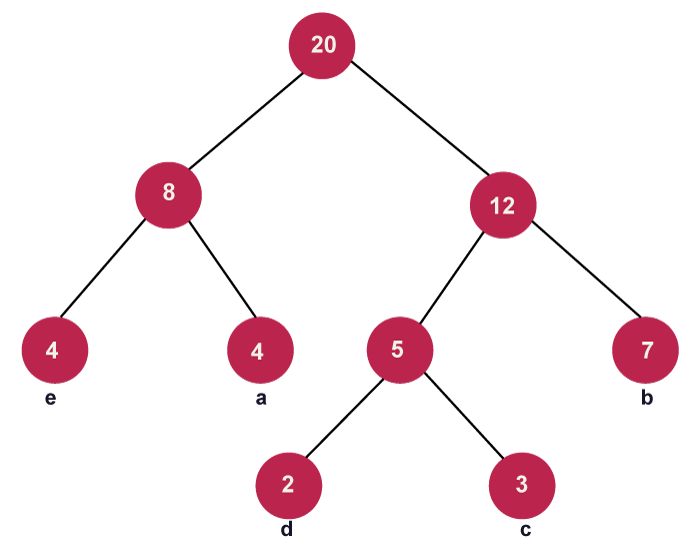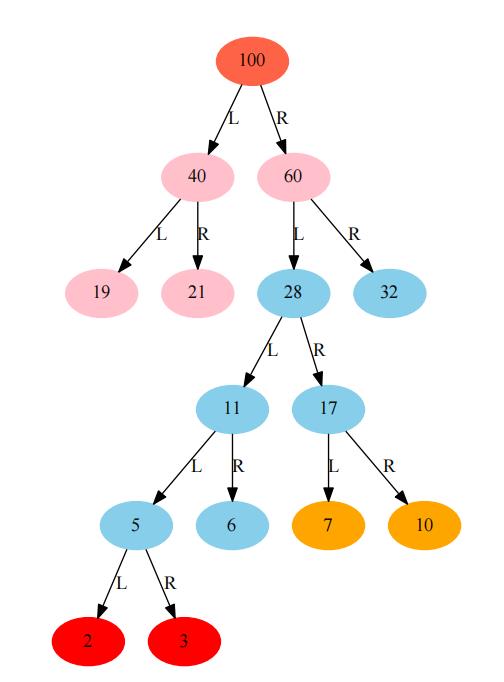在之前的文章二叉树的Python实现 和二叉搜索树(BST)的Python实现 中,笔者分别介绍了二叉树与二叉搜索树的Python实现。本文将在此基础上,介绍Huffman树和Huffman编码的实现。
Huffman树
首先,我们先来看下什么是
给定N个权值作为N个叶子结点,构造一棵二叉树,若该树的带权路径长度达到最小,称这样的二叉树为最优二叉树,也称为哈夫曼树(Huffman
Tree)。哈夫曼树是带权路径长度最短的树,权值较大的结点离根较近。
其中涉及到的概念如下:
树的带权路径长度(WPL):树中所有叶子结点的带权路径长度之和
结点的带权路径长度:是指该结点到树根之间的路径长度与该结点上权的乘积
我们来看个例子:
叶子结点为a,b,c,d,e,图中这颗树的带权路径长度为
4 * 2 + 4 * 2 + 2 * 3 + 3 * 3 + 7 *2 = 45
那么,如何来构建Huffman树呢?
Huffman树的构造(Huffman Algorithm)算法如下:
根据给定的n个权值{w1,w2,…,wn}构成二叉树集合F={T1,T2,…,Tn},其中每棵二叉树Ti中只有一个带权为wi的根结点,其左右子树为空;
在F中选取两棵根结点权值最小的树作为左右子树构造一棵新的二叉树,且置新的二叉树的根结点的权值为左右子树根结点的权值之和;
在F中删除这两棵树,同时将新的二叉树加入F中;
重复2、3, 直到F只含有一棵树为止(得到哈夫曼树)。
利用我们之前实现的二叉树代码(参考文章 二叉搜索树(BST)的Python实现
中的二叉树实现代码),我们接着使用Python代码来实现Huffman树:
1 2 3 4 5 6 7 8 9 10 11 12 13 14 15 16 17 18 19 20 21 22 23 24 25 26 27 28 29 30 31 32 33 34 35 from binary_tree import BTree7 , 19 , 2 , 6 , 32 , 3 , 21 , 10 ]for i in values]while len (tree_list) != 1 :for tree in tree_list]min (values)))min (values)))min (values)))min (values)))True )print ()print ()print ()print (root.level_order())
构建的Huffman树如下:
huffman tree
输出结果为:
1 2 3 4 100 40 19 21 60 28 11 5 2 3 6 17 7 10 32 19 40 21 100 2 5 3 11 6 28 7 17 10 60 32 19 21 40 2 3 5 6 11 7 10 17 28 32 60 100 [[100], [40, 60], [19, 21, 28, 32], [11, 17], [5, 6, 7, 10], [2, 3]]
Huffman编码
Huffman树的一个重要应用是Huffman编码,而Huffman编码常用于数据解压缩。
Huffman coding
在实际使用Huffman数进行编码过程中,我们可以考虑对基本的文字单位(比如字母、汉字或者NLP中的token)按出现次数作为结点权重,去构建一颗Huffman树。此时,在这棵树中,以左子树路径为0,以右子树路径为1。
这样我们就能得到叶子结点的编码,此时该编码为前缀编码(任何一个字符的编码都不能是另一个字符编码的前缀)。
我们来看下面的例子(以字符串``为例):
首先我们对二叉搜索树(BST)的Python实现 中的二叉树进行改成,新增获取叶子结点方法以及二叉树可视化方法修改(将标签L,
R改为0, 1),如下:
1 2 3 4 5 6 7 8 9 10 11 12 13 14 15 16 17 18 19 20 21 22 23 24 25 26 27 28 29 30 31 32 33 34 35 36 37 38 39 40 41 42 43 44 45 46 47 48 49 50 51 class BTree (object ):def __init__ (self, data=None , left=None , right=None ):'Binary Tree' ) @property def leaves (self ):if self.data is None :return []if self.left is None and self.right is None :return [self]return self.left.leaves + self.right.leavesdef print_tree (self, save_path='./Binary_Tree.gv' , label=False ):'skyblue' , 'tomato' , 'orange' , 'purple' , 'green' , 'yellow' , 'pink' , 'red' ]def print_node (node, node_tag ):1 )[0 ]if node.left is not None :str (uuid.uuid1()) str (node.left.data), style='filled' , color=color) '0' if label else '' if node.right is not None :str (uuid.uuid1())str (node.right.data), style='filled' , color=color)'1' if label else '' if self.data is not None :str (uuid.uuid1()) str (self.data), style='filled' , color=sample(colors,1 )[0 ])
Huffman编码示例:
1 2 3 4 5 6 7 8 9 10 11 12 13 14 15 16 17 18 19 20 21 22 23 24 25 26 27 28 29 30 31 32 33 34 35 36 37 38 39 40 41 42 43 44 45 46 47 48 49 50 51 52 53 54 55 56 57 58 59 60 61 62 63 64 65 66 67 68 69 70 71 72 73 74 75 76 77 from binary_tree import BTreefrom collections import Counter'ABCACCDAEAE' print ('各字符出现次数:' , counter_dict)def min_and_index (array ):float ('inf' )None for i in range (len (array)):if array[i] < f_minimum:return f_minimum, flagfor i in counter_dict.values()]while len (tree_list) != 1 :for tree in tree_list]True )'' }while queue:0 )if node.left is not None :'0' if node.right is not None :'1' for node in root.leaves:print (node.data, '--->' , node_dict[node])for char in counter_dict.keys():for node in root.leaves:if counter_dict[char] == node.data and node_dict[node] not in code_dict.values():break print (code_dict)
输出的结果为:
1 2 3 4 5 6 7 各字符出现次数: Counter({'A' : 4 , 'C' : 3 , 'E' : 2 , 'B' : 1 , 'D' : 1 })2 ---> 00 1 ---> 010 1 ---> 011 3 ---> 10 4 ---> 11 'A' : '11' , 'B' : '010' , 'C' : '10' , 'D' : '011' , 'E' : '00' }
构建的Huffman树如下图:
构建的Huffman树
由上可知,对于各个字符的编码方式为:A=11, B=010, C=10, D=011,
E=00.
观察上述的编码方式可知,这种编码方式是前缀编码(每个字母都是叶子结点,没有一个叶子结点在另一个叶子结点的路径上),因此可以用来做字符串的编解码。而且在满足前缀编码的前提下,Huffman编码的编码效率是最高的,即所用的0-1字符数最少,这就是Huffman编码的魅力。
这里,让我们停下脚步来想一想字符串编解码的问题。一种常见的编解码方式为等长编码,比如对于字符串ABCACCDAEAE,共5个字母,因此如果使用0-1编码的话,每个字符需使用3位编码,此时整个字符串需用11
* 3 = 33位编码,这种编码方式效率并不是最高的。
我们来看看Huffman编码的结果:
1 2 3 4 5 6 7 8 9 10 11 12 13 14 15 16 17 18 19 20 21 22 23 24 from math import floor, log2'' for char in string:print ('压缩后的字符串为%s.' % coded_string)if bin (len (counter_dict)).count('1' ) == 1 or len (counter_dict) == 1 :len (counter_dict)))else :len (counter_dict))) + 1 len (string) * biteslen (coded_string)print ('一般方法编码后的字符串长度为%s.' % original_code_bites)print ('Huffman编码后的字符串长度为%s.' % len (coded_string))print ('压缩比为%s.' % round (ratio, 3 ))
输出结果为:
1 2 3 4 5 {'A' : '11' , 'B' : '010' , 'C' : '10' , 'D' : '011' , 'E' : '00' }110101011101001111001100. 33. Huffman 编码后的字符串长度为24. 1.375 .
而对于字符串'BCDEFGhHIJKLMNOPQRSTUVWXYZabcdefghijklmnopqrstuvwxyz'+'A'*10000000,其压缩比达到惊人的6.0。
Huffman decoding
有了Huffman编码,自然也需要对编码后的字符串进行解码。Huffman解码的思想是十分简单的,因为是前缀编码,对于编码后的字符串后,从头开始遍历,直到碰到叶子结点暂停,这样解码出一个字符,如此循环,直到编码后字符串结尾。
我们写一个示例的Huffman解码的Python代码:
1 2 3 4 5 6 7 8 9 10 11 12 13 code_dict = {'A' : '11' , 'B' : '010' , 'C' : '10' , 'D' : '011' , 'E' : '00' }"110101011101001111001100" '' while secret_string:for char, code in code_dict.items():if secret_string.startswith(code):len (code):]break print (decoded_string)
输出结果为ABCACCDAEAE。
注意观察,这样的解码代码效率是比较低的,使用了双重循环,对于长字符串的解码,效率是很低的。我们在本文的txt文件压缩实战部分来演示如何使用bitarray模块来提升Huffman解码效率,从而提升文件的编/解码效率。
其它用途
Huffman树和Huffman编码还有其他用途,其中之一便是刚才讲述过的文件编解码。其它用途列举如下:
对于如下的分类判别树(if-else条件):
如果学生的总成绩数据有10000条,则5%的数据需 1 次比较,15%的数据需 2
次比较,40%的数据需 3 次比较,40%的数据需 4 次比较,因此 10000
个数据比较的次数为:
10000 (5%+2×15%+3×40%+4×40%)=31500次
而如果使用Huffman数,则可将判别次数减少至22000次,这样可以提升判别树的效率。
在NLP中的word2vec算法(一种用于获取词向量的算法)中,对从隐藏层到输出的softmax层这里的计算量进行了改进。为了避免要计算所有词的softmax概率,word2vec采样了霍夫曼树来代替从隐藏层到输出softmax层的映射。
这是Huffman树在NLP领域中的一个精彩应用!
txt文件压缩实战
ok,讲了这么多,我们来看看Huffman编码在文件压缩领域中的作用(也是它的主战场)了。
在这里,我们使用Python中的bitarray模块来提升Huffman编/解码的效率。
1 2 3 4 5 6 7 8 9 10 11 12 13 14 15 16 17 18 19 20 21 22 23 24 25 26 27 28 29 30 31 32 33 34 35 36 37 38 39 40 41 42 43 44 45 46 47 48 49 50 51 52 53 54 55 56 57 58 59 60 61 62 63 64 65 66 67 68 69 70 71 72 73 74 75 76 77 78 79 80 81 82 83 84 import jsonfrom binary_tree import BTreefrom collections import Counterfrom bitarray import bitarraywith open ('test2.txt' , 'r' ) as f:print ('原始文件中的前100个字符:' , string[:100 ])print (counter_dict)def min_and_index (array ):float ('inf' )None for i in range (len (array)):if array[i] < f_minimum:return f_minimum, flagfor i in counter_dict.values()]while len (tree_list) != 1 :for tree in tree_list]'' }while queue:0 )if node.left is not None :'0' if node.right is not None :'1' for char in counter_dict.keys():for node in root.leaves:if counter_dict[char] == node.data and node_dict[node] not in code_dict.values():break '' for char in string:with open ('test2.bin' , 'wb' ) as f:with open ('code_dict.json' , 'w' ) as f:
输出结果为(由于篇幅原因,counter_dict变量只显示了前几个字符):
1 2 原始文件中的前100 个字符: 凡人修仙传 第二千三百零一章-第二千三百五十章 第两千三百零一章 再见灵王 话音刚落,他也不等一干空鱼人再说什么,就一张口,喷出那颗山海珠。 此珠方一飞出,立刻迎风滴溜溜的转动而起,一抹艳丽霞光从上面Counter ({',' : 8278 , '一' : 5472 , '的' : 5226 , '。' : 4718 , ' ' : 3260 , '了' : 2659 , '不' : 1929 , '道' : 1545 , '是' : 1543 , '在' : 1362 , '这' : 1287 , '人' : 1284 , '”' : 1283 , '大' : 1270 })
原始文件test2.txt大小为453K,而编码后的test2.bin文件大小为166K,压缩效果较好。如果我们使用Linux中的tar命令:
tar -zcvf test2.tar.gz test2.txt,压缩后的test2.tar.gz文件大小为183K。
接下来,我们使用code_dict.json对test2.bin进行Huffman解码,示例代码如下:
1 2 3 4 5 6 7 8 9 10 11 12 13 14 15 16 17 import jsonfrom bitarray import bitarraywith open ('code_dict.json' , 'r' ) as f:with open ('test2.bin' , 'rb' ) as fh:len (string) - 8 ] + bitarray(string[len (string) - 8 :].to01().strip('0' ))for key, value in code_dict.items()}print ('编码文件解码后的前100个字符:' , '' .join(dec)[:100 ])
输出结果为:
1 编码文件解码后的前100个字符: 凡人修仙传 第二千三百零一章-第二千三百五十章 第两千三百零一章 再见灵王 话音刚落,他也不等一干空鱼人再说什么,就一张口,喷出那颗山海珠。 此珠方一飞出,立刻迎风滴溜溜的转动而起,一抹艳丽霞光从上面
与原始文件一致。
总结
总结下,本文主要介绍了Huffman树和Huffman编码的原理和Python代码,并介绍了他们的用途,最后再介绍了txt文件压缩实战。
参考文献
霍夫曼编码: https://zh.wikipedia.org/wiki/%E9%9C%8D%E5%A4%AB%E6%9B%BC%E7%BC%96%E7%A0%81
哈夫曼(huffman)树和哈夫曼编码: https://www.cnblogs.com/kubixuesheng/p/4397798.html
word2vec原理(二) 基于Hierarchical Softmax的模型: https://www.cnblogs.com/pinard/p/7243513.html
Decoding a Huffman code with a dictionary: https://stackoverflow.com/questions/33089660/decoding-a-huffman-code-with-a-dictionary



